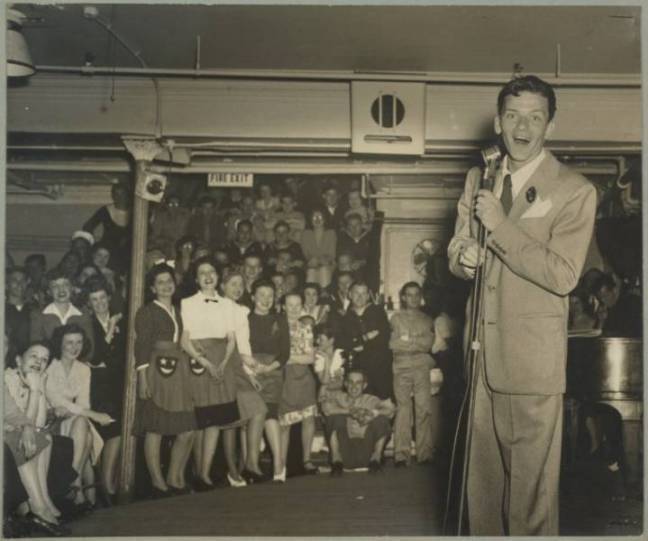Frank Sinatra, "American Icon"
I have found that being an aging baby boomer means coming to grips with the music of my parents' generation. And that means coming to grips with Frank Sinatra. Growing up, I felt I couldn't escape him. He was still on the radio, thanks to hits like "Strangers in the Night," "That's Life," and "Somethin' Stupid." He was on television, in a series of music specials that began in the Sixties. His new movies played in theaters and the old ones on TV. But most of all, he was on our record player. My parents had, and incessantly played (or so it seemed to me) all his albums – the Capitol recordings, the later ones on Reprise, the collaborations with Count Basie, Ella Fitzgerald, and Antonio Carlos Jobim.
I pretty much hated it all.
To me, Sinatra represented everything corny and passé that the cultural revolution of the Sixties was sweeping away. Fedoras? "Ring-a-ding-ding?" His overwrought trashing of rock music? No thanks. To my parents and older relatives, he was Paisan Numero Uno, our greatest ethnic icon. To me, though, Sinatra embodied an Italian American style, and masculinity, I found off-putting and outdated.
But at some point in the past decade or so, I began to appreciate Frank Sinatra, as a complicated public figure, as an Italian American, but especially as a musician. After reading James Kaplan's excellent 2010 biography, Frank: The Voice, I started to listen again to the music I'd scorned as a teenager. Now, somewhat to my surprise, my I-Tunes library is full of Frank. I now can hear what I didn't, or didn’t want to hear – the gorgeous tone, the relaxed but steady swing and rhythmic mastery, the brilliant way with lyrics that turned pop songs into soulful dramatic monologues.
It's not that the bad stuff – the friendships with odious characters like Lucky Luciano and Sam Giancana, the bullying and sexism, the embrace of Reagan and the GOP – didn't matter anymore. It's just that they no longer kept me from appreciating the man's artistry, any more than the Republican politics of the great Cuban singer Celia Cruz kept me from enjoying her "Bemba Colora."
This year marks the 100th anniversary of Sinatra's birth, and the guardians of his legacy – his family, and particularly daughters Tina and Nancy – are making the most of it, with commemorative events on both coasts. So I, the born again Sinatra fan, decided to check out Sinatra: An American Icon, which opened last week at the New York Public Library for the Performing Arts at Lincoln Center. The multi-media exhibition, originally curated by the GRAMMY Museum in Los Angeles, packs quite a bit of Sinatriana into a three-room gallery space. There are photographs and mementos, many provided by the singer's family, that haven't previously been displayed in public. There are videos of concert performances, and audio installations where a visitor can not only listen to Sinatra recordings but also remix them. (If you thought the drums were too loud or the woodwinds too low on "Teach Me Tonight," you can play recording engineer by moving the levers on a mixing console.) Sinatra also liked to paint, and the exhibition includes several of his still lifes and abstract works, in a setting meant to evoke his Palm Springs studio.
Sinatra: An American Icon is organized chronologically, beginning with Sinatra's early years in New Jersey and ending with videos of concerts from the Eighties, his last full decade as a performing artist. (He gave his final concert in 1995, three years before his death at 82.) One of the first things you'll encounter is a replica of an early twentieth century streetcar; the video seen through the windows gives the illusion of riding through the long-gone Hoboken locales of Sinatra's youth. There's a blow-up photo of the Rustic Cabin, the Englewood Cliffs roadhouse that figures prominently in the singer's early career: Harry James heard Sinatra in a live performance broadcast from the venue, and subsequently gave him his first big break as a singer in James' big band. You can hear what Sinatra sounded like in those days at an audio station; touch the screen for "From the Bottom of My Heart," from 1939, an early instance of his talent for making something interesting out of banal material.
The section of the exhibit focusing on his movie career includes posters, photographs, and memorabilia, like Sinatra's and Gene Kelly's dancing shoes from "On the Town," placed side by side. The exhibit's only nod to Sinatra's politics – and it is an oblique one – comes with "The House I Live In," the short film for which he won a "special" Academy Award in 1946. Built around the Sinatra recording of the same name, the film begins with the singer kindly but firmly schooling some New York City kids about anti-Semitism and racism. "The House I Live In" was an exemplar of Popular Front culture – Earl Robinson, a Communist, composed the music, and Abel Meeropol, who later adopted the sons of Julius and Ethel Rosenberg, wrote the lyrics – and one of the reasons why J. Edgar Hoover and Joe McCarthy thought Sinatra was a Communist sympathizer.
The exhibit doesn't provide any of that context, however, and in fact, it shies away from any hint of controversy. This is, after all, an official, family-approved tribute, not a warts-and-all portrait. So it's no surprise that there's nothing about his arrests or his FBI file, no photos of him in Havana with Lucky Luciano or performing in apartheid-era South Africa. The sanitizing becomes absurd, though, when it comes to Sinatra's boozing. In front of a large, black and white photo of the singer onstage, his arms extended to embrace the audience, there is a wheeled cart with a decanter containing what is supposed to be Sinatra's favorite whiskey, Jack Daniels. Angelo Lucchesi, who designed the decanter, became a close friend of Sinatra's after he supplied the singer with a case of his preferred libation. In a video, Frank Sinatra, Jr. reminisces with Lucchesi about his father's drinking habits, claiming that he always avoided sweet and mixed drinks, and would just take a sip of Jack Daniels, with a little water. Sinatra, though, was no casual sipper but in reality a functioning alcoholic. But that would be an inconvenient truth for an exhibit that, as the program notes, was "made possible through the generous support of Jack Daniel's Sinatra Select."
Sinatra: An American Icon runs through September 4, 2015, at the New York Public Library for the Performing Arts. The Library is presenting a number of events, including film screenings, to commemorate the centennial of the singer's birth. For a full listing, see NYPL.org/Sinatra.





































i-Italy
Facebook
Google+
This work may not be reproduced, in whole or in part, without prior written permission.
Questo lavoro non può essere riprodotto, in tutto o in parte, senza permesso scritto.